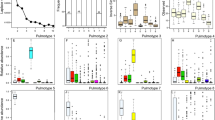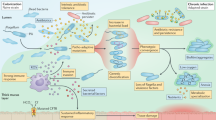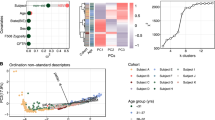Abstract
There is a poor understanding of how the physiology of polymicrobial communities in cystic fibrosis (CF) lungs contributes to pulmonary exacerbations and lung function decline. In this study, a microbial culture system based on the principles of the Winogradsky column (WinCF system) was developed to study the physiology of CF microbes. The system used glass capillary tubes filled with artificial sputum medium to mimic a clogged airway bronchiole. Chemical indicators were added to observe microbial physiology within the tubes. Characterization of sputum samples from seven patients showed variation in pH, respiration, biofilm formation and gas production, indicating that the physiology of CF microbial communities varied among patients. Incubation of homogenized tissues from an explant CF lung mirrored responses of a Pseudomonas aeruginosa pure culture, supporting evidence that end-stage lungs are dominated by this pathogen. Longitudinal sputum samples taken through two exacerbation events in a single patient showed that a two-unit drop in pH and a 30% increase in gas production occurred in the tubes prior to exacerbation, which was reversed with antibiotic treatment. Microbial community profiles obtained through amplification and sequencing of the 16S rRNA gene showed that fermentative anaerobes became more abundant during exacerbation and were then reduced during treatment where P. aeruginosa became the dominant bacterium. Results from the WinCF experiments support the model where two functionally different CF microbial communities exist, the persistent Climax Community and the acute Attack Community. Fermentative anaerobes are hypothesized to be the core members of the Attack Community and production of acidic and gaseous products from fermentation may drive developing exacerbations. Treatment targeting the Attack Community may better resolve exacerbations and resulting lung damage.
Similar content being viewed by others
Log in or create a free account to read this content
Gain free access to this article, as well as selected content from this journal and more on nature.com
or
Change history
17 March 2014
This article has been corrected since Advance Online Publication and a corrigendum is also printed in this issue
References
Barker M, Hengst M, Schmid J, Buers H-J, Mittermaier B, Klemp D et al. (2006). Volatile organic compounds in the exhaled breath of young patients with cystic fibrosis. Eur Respir J 27: 929–936.
Barth AL, Pitt TL . (1996). The high amino-acid content of sputum from cystic fibrosis patients promotes growth of auxotrophic Pseudomonas aeruginosa. J Med Microbiol 45: 110–119.
Bjarnsholt T, Jensen PØ, Fiandaca MJ, Pedersen J, Hansen CR, Andersen CB et al. (2009). Pseudomonas aeruginosa biofilms in the respiratory tract of cystic fibrosis patients. Pediatr Pulmonol 44: 547–558.
Burns JL, Rolain J-M . (2014). Culture-based diagnostic microbiology in cystic fibrosis: can we simplify the complexity? J Cyst Fibros 13: 1–9.
Caporaso JG, Lauber CL, Walters WA, Berg-Lyons D, Lozupone CA, Turnbaugh PJ et al. (2011). Global patterns of 16S rRNA diversity at a depth of millions of sequences per sample. Proc Natl Acad Sci USA 108 Suppl: 4516–4522.
Carmody LA, Zhao J, Schloss PD, Petrosino JF, Murray S, Young VB et al. (2013). Changes in cystic fibrosis airway microbiota at pulmonary exacerbation. Ann Am Thorac Soc 10: 179–187.
Chung JCS, Becq J, Fraser L, Schulz-Trieglaff O, Bond NJ, Foweraker J et al. (2012). Genomic variation among contemporary Pseudomonas aeruginosa isolates from chronically infected cystic fibrosis patients. J Bacteriol 194: 4857–4866.
Cole JR, Chai B, Farris RJ, Wang Q, Kulam SA, McGarrell DM et al. (2005). The Ribosomal Database Project (RDP-II): sequences and tools for high-throughput rRNA analysis. Nucleic Acids Res 33: D294–D296.
Colman JJ, Swanson AL, Meinardi S, Sive BC, Blake DR, Rowland FS . (2001). Description of the analysis of a wide range of volatile organic compounds in whole air samples collected during PEM-tropics A and B. Anal Chem 73: 3723–3731.
Conrad D, Haynes M, Salamon P, Rainey PB, Youle M, Rohwer F . (2012). Cystic fibrosis therapy: a community ecology perspective. Am J Respir Cell Mol Biol 48: 150–156.
De Boer K, Vandemheen KL, Tullis E, Doucette S, Fergusson D, Freitag A et al. (2011). Exacerbation frequency and clinical outcomes in adult patients with cystic fibrosis. Thorax 66: 680–685.
Delhaes L, Monchy S, Fréalle E, Hubans C, Salleron J, Leroy S et al. (2012). The airway microbiota in cystic fibrosis: a complex fungal and bacterial community—implications for therapeutic management. PLoS One 7: e36313.
Deschaght P, Schelstraete P, Van Simaey L, Vanderkercken M, Raman A, Mahieu L et al. (2013). Is the improvement of CF patients, hospitalized for pulmonary exacerbation, correlated to a decrease in bacterial load? PLoS One 8: e79010.
Duan K, Dammel C, Stein J, Rabin H, Surette MG . (2003). Modulation of Pseudomonas aeruginosa gene expression by host microflora through interspecies communication. Mol Microbiol 50: 1477–1491.
Fenchel T, Finlay B . (2008). Oxygen and the spatial structure of microbial communities. Biol Rev Camb Philos Soc 83: 553–569.
Fodor Aa, Klem ER, Gilpin DF, Elborn JS, Boucher RC, Tunney MM et al. (2012). The adult cystic fibrosis airway microbiota is stable over time and infection type, and highly resilient to antibiotic treatment of exacerbations. PLoS One 7: e45001.
Frimmersdorf E, Horatzek S, Pelnikevich A, Wiehlmann L, Schomburg D . (2010). How Pseudomonas aeruginosa adapts to various environments: a metabolomic approach. Environ Microbiol 12: 1734–1747.
Fuchs HJ, Borowitz DS, Christiansen DH, Morris EM, Nash ML, Ramsey BW et al. (1994). Effect of aerosolized recombinant human DNase on exacerbations of respiratory symptoms and on pulmonary function in patients with cystic fibrosis. The Pulmozyme Study Group. N Engl J Med 331: 637–642.
Fung C, Naughton S, Turnbull L, Tingpej P, Rose B, Arthur J et al. (2010). Gene expression of Pseudomonas aeruginosa in a mucin-containing synthetic growth medium mimicking cystic fibrosis lung sputum. J Med Microbiol 59: 1089–1100.
Ghio AJ, Roggli VL, Soukup JM, Richards JH, Randell SH, Muhlebach MS . (2012). Iron accumulates in the lavage and explanted lungs of cystic fibrosis patients. J Cyst Fibros 12: 390–398.
Goddard AF, Staudinger BJ, Dowd SE, Joshi-Datar A, Wolcott RD, Aitken ML et al. (2012). Direct sampling of cystic fibrosis lungs indicates that DNA-based analyses of upper-airway specimens can misrepresent lung microbiota. Proc Natl Acad Sci USA 109: 13769–13774.
Grasemann H, Ioannidis I, Tomkiewicz RP, de Groot H, Rubin BK, Ratjen F . (1998). Nitric oxide metabolites in cystic fibrosis lung disease. Arch Dis Child 78: 49–53.
Haas AF, Gregg AK, Smith JE, Abieri ML, Hatay M, Rohwer F . (2013). Visualization of oxygen distribution patterns caused by coral and algae. PeerJ 1: e106.
Hare NJ, Soe CZ, Rose B, Harbour C, Codd R, Manos J et al. (2012). Proteomics of Pseudomonas aeruginosa Australian epidemic strain 1 (AES-1) cultured under conditions mimicking the cystic fibrosis lung reveals increased iron acquisition via the siderophore pyochelin. J Proteome Res 11: 776–795.
Harrison F . (2007). Microbial ecology of the cystic fibrosis lung. Microbiology 153: 917–923.
Hauser AR, Jain M, Bar-Meir M, McColley Sa . (2011). Clinical significance of microbial infection and adaptation in cystic fibrosis. Clin Microbiol Rev 24: 29–70.
Hill D, Rose B, Pajkos A, Robinson M, Bye P, Bell S et al. (2005). Antibiotic susceptabilities of Pseudomonas aeruginosa isolates derived from patients with cystic fibrosis under aerobic, anaerobic, and biofilm conditions. J Clin Microbiol 43: 5085–5090.
Hogardt M, Heesemann J . (2010). Adaptation of Pseudomonas aeruginosa during persistence in the cystic fibrosis lung. Int J Med Microbiol 300: 557–562.
Hunter RC, Klepac-Ceraj V, Lorenzi MM, Grotzinger H, Martin TR, Newman DK . (2012). Phenazine content in the cystic fibrosis respiratory tract negatively correlates with lung function and microbial complexity. Am J Respir Cell Mol Biol 47: 738–745.
Jones KL, Hegab AH, Hillman BC, Simpson KL, Jinkins PA, Grisham MB et al. (2000). Elevation of nitrotyrosine and nitrate concentrations in cystic fibrosis sputum. Pediatr Pulmonol 30: 79–85.
Kamboures MA, Blake DR, Cooper DM, Newcomb RL, Barker M, Larson JK et al. (2005). Breath sulfides and pulmonary function in cystic fibrosis. Proc Natl Acad Sci USA 102: 15762–15767.
King P, Citron DM, Griffith DC, Lomovskaya O, Dudley MN . (2010). Effect of oxygen limitation on the in vitro activity of levofloxacin and other antibiotics administered by the aerosol route against Pseudomonas aeruginosa from cystic fibrosis patients. Diagn Microbiol Infect Dis 66: 181–186.
Klockgether J, Miethke N, Kubesch P, Bohn Y-S, Brockhausen I, Cramer N et al. (2013). Intraclonal diversity of the Pseudomonas aeruginosa cystic fibrosis airway isolates TBCF10839 and TBCF121838: distinct signatures of transcriptome, proteome, metabolome, adherence and pathogenicity despite an almost identical genome sequence. Environ Microbiol 15: 191–210.
Kozich JJ, Westcott SL, Baxter NT, Highlander SK, Schloss PD . (2013). Development of a dual-index sequencing strategy and curation pipeline for analyzing amplicon sequence data on the MiSeq Illumina sequencing platform. Appl Environ Microbiol 79: 5112–5120.
Kurkivuori J, Salaspuro V, Kaihovaara P, Kari K, Rautemaa R, Grönroos L et al. (2007). Acetaldehyde production from ethanol by oral streptococci. Oral Oncol 43: 181–186.
Lim YW, Evangelista JS, Schmieder R, Bailey B, Haynes M, Furlan M et al. (2013). Clinical insights from metagenomic analysis of cystic fibrosis sputum. J Clin Microbiol 52: 425–457.
Lim YW, Schmieder R, Haynes M, Furlan M, Matthews TD, Whiteson K et al. (2013). Mechanistic model of Rothia mucilaginosa adaptation toward persistence in the CF lung, based on a genome reconstructed from metagenomic data. PLoS One 8: e64285.
Lim YW, Schmieder R, Haynes M, Willner D, Furlan M, Youle M et al. (2012). Metagenomics and metatranscriptomics: Windows on CF-associated viral and microbial communities. J Cyst Fibros 12: 164–154.
Lipuma JJ . (2010). The changing microbial epidemiology in cystic fibrosis. Clin Microbiol Rev 23: 299–323.
Mitchell G, Séguin DL, Asselin A-E, Déziel E, Cantin AM, Frost EH et al. (2010). Staphylococcus aureus sigma B-dependent emergence of small-colony variants and biofilm production following exposure to Pseudomonas aeruginosa 4-hydroxy-2-heptylquinoline-N-oxide. BMC Microbiol 10: 33.
Morris RL, Schmidt TM . (2013). Shallow breathing: bacterial life at low O(2). Nat Rev Microbiol 11: 205–212.
Palmer KL, Aye LM, Whiteley M . (2007). Nutritional cues control Pseudomonas aeruginosa multicellular behavior in cystic fibrosis sputum. J Bacteriol 189: 8079–8087.
Palmer KL, Mashburn LM, Singh PK, Whiteley M . (2005). Cystic fibrosis sputum supports growth and cues key aspects of Pseudomonas aeruginosa physiology. J Bacteriol 187: 5267–5277.
Pezzulo AA, Tang XX, Hoegger MJ, Alaiwa MHA, Ramachandran S, Moninger TO et al. (2012). Reduced airway surface pH impairs bacterial killing in the porcine cystic fibrosis lung. Nature 487: 109–113.
Price KE, Hampton TH, Gifford AH, Dolben EL, Hogan DA, Morrison HG et al. (2013). Unique microbial communities persist in individual cystic fibrosis patients throughout a clinical exacerbation. Microbiome 1: 27.
Quast C, Pruesse E, Yilmaz P, Gerken J, Schweer T, Yarza P et al. (2013). The SILVA ribosomal RNA gene database project: improved data processing and web-based tools. Nucleic Acids Res 41: D590–D596.
Quinn RA, Lim YW, Maughan H, Conrad D, Rohwer F, Whiteson KL . (2014). Biogeochemical forces shape the composition and physiology of polymicrobial communities in the cystic fibrosis lung. MBio 5: e00956–13.
Rabin HR, Surette MG . (2012). The cystic fibrosis airway microbiome. Curr Opin Pulm Med 18: 622–627.
Reid DW, Lam QT, Schneider H, Walters EH . (2004). Airway iron and iron-regulatory cytokines in cystic fibrosis. Eur Respir J 24: 286–291.
Rogers GB, Marsh P, Stressmann aF, Allen CE, Daniels TVW, Carroll MP et al. (2010). The exclusion of dead bacterial cells is essential for accurate molecular analysis of clinical samples. Clin Microbiol Infect 16: 1656–1658.
Schmieder R, Edwards R . (2011). Quality control and preprocessing of metagenomic datasets. Bioinformatics 27: 863–864.
Schobert M, Jahn D . (2010). Anaerobic physiology of Pseudomonas aeruginosa in the cystic fibrosis lung. Int J Med Microbiol 300: 549–556.
Segal W, Starkey RL . (1968). Methionine and identity of the microbial decomposition of methionine and identity of the resulting sulfur products. J Bacteriol 98: 908–913.
Shin H-W, Umber BJ, Meinardi S, Leu S-Y, Zaldivar F, Blake DR et al. (2009). Acetaldehyde and hexanaldehyde from cultured white cells. J Transl Med 7: 31.
Sibley CD, Parkins MD, Rabin HR, Duan K, Norgaard JC, Surette MG . (2008). A polymicrobial perspective of pulmonary infections exposes an enigmatic pathogen in cystic fibrosis patients. PNAS 105: 15070–15075.
Sibley CD, Surette MG . (2011). The polymicrobial nature of airway infections in cystic fibrosis: Cangene Gold Medal Lecture. Can J Microbiol 57: 69–77.
Stenbit AE, Flume Pa . (2011). Pulmonary exacerbations in cystic fibrosis. Curr Opin Pulm Med 17: 442–447.
Stites SW, Walters B, O’Brien-Ladner A, Bailey K, Wesselius L . (1998). Increased iron and ferritin content of sputum from patients with cystic fibrosis or chronic bronchitis. Chest 114: 814.
Stressmann Fa, Rogers GB, Marsh P, Lilley AK, Daniels TWV, Carroll MP et al. (2011). Does bacterial density in cystic fibrosis sputum increase prior to pulmonary exacerbation? J Cyst Fibros 10: 357–365.
Tate S, MacGregor G, Davis M, Innes JA, Greening AP . (2002). Airways in cystic fibrosis are acidified: detection by exhaled breath condensate. Thorax 57: 926–929.
Thomas SR, Ray A, Hodson ME, Pitt TL . (2000). Increased sputum amino acid concentrations and auxotrophy of Pseudomonas aeruginosa in severe cystic fibrosis lung disease. Thorax 55: 795–797.
Tunney MM, Field TR, Moriarty TF, Patrick S, Doering G, Muhlebach MS et al. (2008). Detection of anaerobic bacteria in high numbers in sputum from patients with cystic fibrosis. Am J Respir Crit Care Med 177: 995–1001.
Twomey KB, Alston M, An S-Q, O’Connell OJ, McCarthy Y, Swarbreck D et al. (2013). Microbiota and metabolite profiling reveal specific alterations in bacterial community structure and environment in the cystic fibrosis airway during exacerbation. PLoS One 8: e82432.
Umber BJ, Shin H-W, Meinardi S, Leu S-Y, Zaldivar F, Cooper DM et al. (2013). Gas signatures from Escherichia coli and Escherichia coli-inoculated human whole blood. Clin Transl Med 2: 13.
Venkataraman A, Rosenbaum MA, Werner JJ, Winans SC, Angenent LT . (2014). Metabolite transfer with the fermentation product 2,3-butanediol enhances virulence by Pseudomonas aeruginosa. ISME J 8: 1210–1220.
Verhoogt HJ, Smit H, Abee T, Gamper M, Driessen aJ, Haas D et al. (1992). arcD, the first gene of the arc operon for anaerobic arginine catabolism in Pseudomonas aeruginosa, encodes an arginine-ornithine exchanger. J Bacteriol 174: 1568–1573.
Whiteson KL, Bailey B, Bergkessel M, Conrad D, Delhaes L, Felts B et al. (2014). The upper respiratory tract as a microbial source for pulmonary infections in cystic fibrosis. Parallels from island biogeography. Am J Respir Crit Care Med 189: 1309–1315.
Whiteson KL, Meinardi S, Lim YW, Schmieder R, Maughan H, Quinn R et al. (2014). Breath gas metabolites and bacterial metagenomes from cystic fibrosis airways indicate active pH neutral 2,3-butanedione fermentation. ISME J 8: 1247–1258.
Willner D, Furlan M, Haynes M, Schmieder R, Angly FE, Silva J et al. (2009). Metagenomic analysis of respiratory tract DNA viral communities in cystic fibrosis and non-cystic fibrosis individuals. PLoS One 4: e7370.
Willner D, Haynes MR, Furlan M, Schmieder R, Lim YW, Rainey PB et al. (2012). Spatial distribution of microbial communities in the cystic fibrosis lung. ISME J 6: 471–474.
Winogradsky SN . (1897). O roli mikrobov v krugovorote zhizni (On the role of microbes in the cycle of life). Arkhiv Biol Nauk 7: 1–27.
Wolffs P, Norling B, Rådström P . (2005). Risk assessment of false-positive quantitative real-time PCR results in food, due to detection of DNA originating from dead cells. J Microbiol Methods 60: 315–323.
Worlitzsch D, Rintelen C, Böhm K, Wollschläger B, Merkel N, Borneff-Lipp M et al. (2009). Antibiotic-resistant obligate anaerobes during exacerbations of cystic fibrosis patients. Clin Microbiol Infect 15: 454–460.
Worlitzsch D, Tarran R, Ulrich M, Schwab U, Cekici A, Meyer KC et al. (2002). Effects of reduced mucus oxygen concentration in airway Pseudomonas infections of cystic fibrosis patients. J Clin Invest 109: 317–325.
Yang L, Jelsbak L, Molin S . (2011). Microbial ecology and adaptation in cystic fibrosis airways. Environ Microbiol 13: 1682–1689.
Yao W, Byrne RH . (2001). Spectrophotometric determination of freshwater pH using bromocresol purple and phenol red. Environ Sci Technol 35: 1197–1201.
Young G, Turner S, Davies JK, Sundqvist G, Figdor D . (2007). Bacterial DNA persists for extended periods after cell death. J Endod 33: 1417–1420.
Zemanick ET, Harris JK, Wagner BD, Robertson CE, Sagel SD, Stevens MJ et al. (2013). Inflammation and airway microbiota during cystic fibrosis pulmonary exacerbations. PLoS One 8: e62917.
Zhao J, Schloss PD, Kalikin LM, Carmody La, Foster BK, Petrosino JF et al. (2012). Decade-long bacterial community dynamics in cystic fibrosis airways. Proc Natl Acad Sci USA 109: 5809–5814.
Acknowledgements
This work was supported by the National Institute of Health through grant R01 GM095384-01 awarded to Forest Rohwer. The project was partially supported by the National Institutes of Health, grant UL1RR031980 for years 1 and 2 of CTSA funding and/or UL1TR000100 during year 3 and beyond of CTSA funding. Funding was also provided by the Canadian Institute for Advanced Research and by the Cystic Fibrosis Research Inc. Elizabeth Nash memorial fellowship awarded to Robert Quinn. We also thank Mark Hatay and Amadeo Candido for their contributions to the imaging set up and mucus_analyzer script development.
Author information
Authors and Affiliations
Corresponding author
Ethics declarations
Competing interests
The authors declare no conflict of interest.
Additional information
Supplementary Information accompanies this paper on The ISME Journal website
Supplementary information
Rights and permissions
About this article
Cite this article
Quinn, R., Whiteson, K., Lim, YW. et al. A Winogradsky-based culture system shows an association between microbial fermentation and cystic fibrosis exacerbation. ISME J 9, 1024–1038 (2015). https://doi.org/10.1038/ismej.2014.234
Received:
Revised:
Accepted:
Published:
Issue date:
DOI: https://doi.org/10.1038/ismej.2014.234
This article is cited by
-
Metabolomic profiling of Burkholderia cenocepacia in synthetic cystic fibrosis sputum medium reveals nutrient environment-specific production of virulence factors
Scientific Reports (2021)
-
Neutrophilic proteolysis in the cystic fibrosis lung correlates with a pathogenic microbiome
Microbiome (2019)
-
Acquisition and adaptation of the airway microbiota in the early life of cystic fibrosis patients
Molecular and Cellular Pediatrics (2017)
-
Novel antibiotic combinations proposed for treatment of Burkholderia cepacia complex infections
Antimicrobial Resistance & Infection Control (2017)
-
Microbial, host and xenobiotic diversity in the cystic fibrosis sputum metabolome
The ISME Journal (2016)



